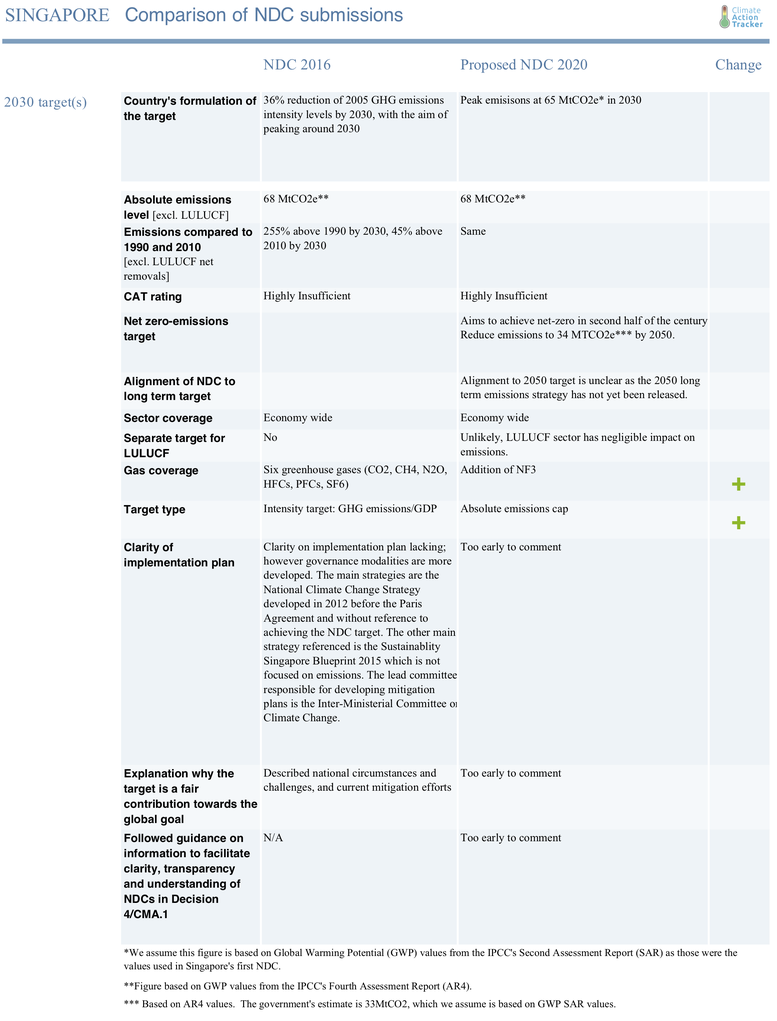CAT Climate Target Update Tracker
Singapore
Summary
Singapore’s proposed NDC update does not further limit GHG emissions beyond its earlier NDC
Singapore announced its proposed NDC update in February 2020. While it will improve the form of its target, moving from an emissions intensity target to an absolute cap on emissions, the level at which it will limit emissions remains unchanged. Its CAT rating remains as ‘Highly Insufficient’. Singapore should scale up its climate action before submitting its final NDC update.
Scroll down for a detailed analysis of Singapore’s NDC update or click the button to view the latest CAT assessment for Singapore.
CAT analysis of NDC update


On 28 February in a speech to Parliament, Teo Chee Hean, Singapore’s Coordinating Minister for National Security and Chairman of the Inter-Ministerial Committee on Climate Change, outlined the government’s plans to update its NDC. The CAT analysis is based on the details outlined by the Minister in his speech and will be updated as more information becomes available.
The Minister described the NDC update as ‘enhanced’. Yet, the Singapore government has acknowledged that the proposed update is just a reframing of the current target. The National Climate Change Secretariat notes that the update is ‘consistent with Singapore’s existing 2030 NDC’.
The purpose of the NDC update process is to scale up climate action and reduce GHG emissions. In 2015, Governments formally acknowledged their collective commitments under the Paris Agreement would not meet the goal of limiting warming to 1.5°C, which resulted in planning for NDC updates in 2020. Updating an NDC without further limiting GHG emissions undermines the Paris Agreement update process and violates the agreement that each successive NDC should represent a progression in climate action.
If Singapore were to officially adopt this proposed update, its CAT rating would remain ‘highly insufficient’. This rating indicates that Singapore’s climate commitment in 2020 is not consistent with holding warming to below 2°C, let alone limiting it to 1.5°C as required under the Paris Agreement. This means Singapore’s climate commitment is not in line with any interpretation of a “fair” approach to the Paris Agreement’s 1.5°C limit.
Setting an absolute target is a positive step, but Singapore also needs to increase its ambition. An absolute target provides transparency by setting a concrete level of emissions that will be reached, and allows for easy country comparison. Moving to an absolute target is commendable as absolute emissions do not depend on other factors such as GDP.
The current NDC has a clear lead committee responsible for developing mitigation plans, but unclear implementation plans. The Inter-Ministerial Committee on Climate Change (IMCCC) is responsible for leading government mitigation efforts. The main strategies referenced for Singapore’s NDC planning process are the National Climate Change Strategy and the Sustainability Singapore Blueprint 2015. The National Climate Change Strategy was developed in 2012 before the Paris Agreement and does not reference the NDC target. The Sustainability Singapore Blueprint 2015 does not focus on emissions. Singapore’s NDC update should provide clarity on its NDC implementation plans.
The NDC update will include Nitrogen Trifluoride (NF3) gas, in addition to the greenhouse gases already covered (CO2, CH4, N2O, HFCs, PFCs, SF6). NF3 reporting is required by 2024, but Singapore is including the gas early in its NDC update. It is unclear how much NF3 gas contributes to Singapore’s overall emissions. Including NF3 in the target provides full gas coverage and transparency.
Governments agreed in Paris to set long term strategies by 2020. Singapore has also announced it will submit a long term low emissions strategy (LEDS) for 2050 and beyond. The strategy plans to halve Singapore’s peak emissions levels by 2050 (34 MtCO2e by 2050, in AR4 value terms), and reach net zero emissions by the second half of the century.
Links
Stay informed
Subscribe to our newsletter
